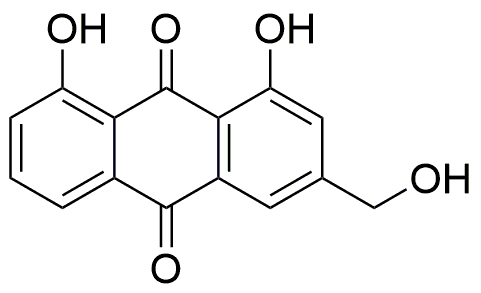Aloe emodin is widely utilized in research focused on:
- Pharmaceutical Development: Known for its potential anti-inflammatory and anti-cancer properties, it is being explored in the formulation of new drugs aimed at treating various diseases.
- Cosmetics: Commonly used in skin care products for its soothing and healing properties, it helps in promoting skin health and reducing irritation.
- Food Industry: As a natural colorant and preservative, it is incorporated into food products to enhance appearance and shelf life while providing health benefits.
- Traditional Medicine: Employed in herbal remedies, it is recognized for its laxative effects and is often used in formulations for digestive health.
- Research Studies: Frequently used in laboratory studies to investigate its effects on cell growth and apoptosis, aiding in the understanding of cancer biology.
General Information
Properties
Safety and Regulations
Applications
Aloe emodin is widely utilized in research focused on:
- Pharmaceutical Development: Known for its potential anti-inflammatory and anti-cancer properties, it is being explored in the formulation of new drugs aimed at treating various diseases.
- Cosmetics: Commonly used in skin care products for its soothing and healing properties, it helps in promoting skin health and reducing irritation.
- Food Industry: As a natural colorant and preservative, it is incorporated into food products to enhance appearance and shelf life while providing health benefits.
- Traditional Medicine: Employed in herbal remedies, it is recognized for its laxative effects and is often used in formulations for digestive health.
- Research Studies: Frequently used in laboratory studies to investigate its effects on cell growth and apoptosis, aiding in the understanding of cancer biology.
Documents
Safety Data Sheets (SDS)
The SDS provides comprehensive safety information on handling, storage, and disposal of the product.
Product Specification (PS)
The PS provides a comprehensive breakdown of the product’s properties, including chemical composition, physical state, purity, and storage requirements. It also details acceptable quality ranges and the product's intended applications.
Certificates of Analysis (COA)
Search for Certificates of Analysis (COA) by entering the products Lot Number. Lot and Batch Numbers can be found on a product’s label following the words ‘Lot’ or ‘Batch’.
*Catalog Number
*Lot Number
Certificates Of Origin (COO)
This COO confirms the country where the product was manufactured, and also details the materials and components used in it and whether it is derived from natural, synthetic, or other specific sources. This certificate may be required for customs, trade, and regulatory compliance.
*Catalog Number
*Lot Number
Safety Data Sheets (SDS)
The SDS provides comprehensive safety information on handling, storage, and disposal of the product.
DownloadProduct Specification (PS)
The PS provides a comprehensive breakdown of the product’s properties, including chemical composition, physical state, purity, and storage requirements. It also details acceptable quality ranges and the product's intended applications.
DownloadCertificates of Analysis (COA)
Search for Certificates of Analysis (COA) by entering the products Lot Number. Lot and Batch Numbers can be found on a product’s label following the words ‘Lot’ or ‘Batch’.
*Catalog Number
*Lot Number
Certificates Of Origin (COO)
This COO confirms the country where the product was manufactured, and also details the materials and components used in it and whether it is derived from natural, synthetic, or other specific sources. This certificate may be required for customs, trade, and regulatory compliance.


